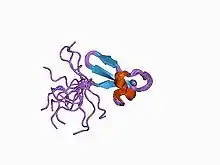| Copper fist domain | |||||||||||
|---|---|---|---|---|---|---|---|---|---|---|---|
 Structure of a zinc domain conserved in yeast copper-regulated transcription factors.[1] | |||||||||||
| Identifiers | |||||||||||
| Symbol | Copper fist | ||||||||||
| Pfam | PF00649 | ||||||||||
| InterPro | IPR001083 | ||||||||||
| SMART | SM00412 | ||||||||||
| PROSITE | PS50073 | ||||||||||
| SCOP2 | 1co4 / SCOPe / SUPFAM | ||||||||||
| |||||||||||
Copper fist is an N-terminal domain involved in copper-dependent DNA binding. It is named for its resemblance to a fist closed around a penny. Functionally, the "penny" is a collection of copper ions and the "knuckles" of the fist are proteins that interact with the promoter of the metallothionein gene,[1] enhancing its transcription by creating a more stable binding site for RNA polymerase during transcription, an essential step in DNA replication.[2]
Structure and function
The copper fist domain contains an array of zinc-binding polymers (Cys-X2-Cys-X8-Cys-X-His)[1] that form a three-stranded antiparallel β-sheet, a secondary protein structure composed of beta strands connected by hydrogen bonds,[3] with two short helical segments that protrude from the end of the β-sheet. One primary function of the copper fist domain is to maintain copper homeostasis. Copper is an essential trace element involved in various biological processes, including energy production, antioxidant defense, and the functioning of metalloenzymes; however, high levels of copper can be toxic to many organisms.[4]
Fungal transcription factors and metallothionein regulation
Another function of the copper fist domain is the activation and regulation of the metallothionein gene. Metallothionein, a type of protein that binds metal in cells,[5] is responsible for maintaining metal-based homeostasis, protecting from heavy metal toxicity, and oxidative stress.[6] The promoter of the metallothionein gene reacts with certain metals to achieve these properties.[7] The copper fist domain can be found in some fungal transcription factors (MAC1, Cuf1, AfMac1, Afu2g01190, Afu6g07780, etc.).[8]
The copper fist DNA binding domain of yeast and other fungi interacts with copper when it is encountered in excess, as high levels of copper can be very toxic to fungal cell walls and membranes.[2][9] The proteins of the domain proteins activate, improve, and stabilize the transcription of the metallothionein gene in response to copper ions.[10] The copper fist domain is similar in structure to metallothionein itself, and it undergoes a large conformational change upon binding to copper, which allows for the binding of DNA and the enhancement of the promoter region of the metallothionein gene.[1]
ACE1 and AMT1 are examples of copper fist fungal transcription factors. ACE1 can activate metallothionein to prevent the toxicity caused by excess copper.[11] AMT1 functions similarly in reducing potentially toxic copper levels.[12] MAC1 is another copper sensitive gene that is essential for both copper mediation and copper usage in yeast.[13]
References
- 1 2 3 4 Turner RB, Smith DL, Zawrotny ME, Summers MF, Posewitz MC, Winge DR (July 1998). "Solution structure of a zinc domain conserved in yeast copper-regulated transcription factors". Nature Structural Biology. 5 (7): 551–555. doi:10.1038/805. PMID 9665167. S2CID 12015694.
- 1 2 "Addgene: Promoters". www.addgene.org. Retrieved 2023-11-21.
- ↑ Reeb J, Rost B (January 2019). "Secondary Structure Prediction". In Ranganathan S, Gribskov M, Nakai K, Schönbach C (eds.). Encyclopedia of Bioinformatics and Computational Biology. Oxford: Academic Press. pp. 488–496. doi:10.1016/B978-0-12-809633-8.20267-7. ISBN 978-0-12-811432-2. S2CID 226247584.
- ↑ Koch KA, Allard S, Santoro N, Côté J, Thiele DJ (June 2001). "The Candida glabrata Amt1 copper-sensing transcription factor requires Swi/Snf and Gcn5 at a critical step in copper detoxification". Molecular Microbiology. 40 (5): 1165–1174. doi:10.1046/j.1365-2958.2001.02458.x. hdl:2027.42/74057. PMID 11401720. S2CID 22858677.
- ↑ Smith DR, Nordberg M (January 2015). "Chapter 2 - General Chemistry, Sampling, Analytical Methods, and Speciation". In Nordberg GF, Fowler BA, Nordberg M (eds.). Handbook on the Toxicology of Metals (Fourth ed.). San Diego: Academic Press. pp. 15–44. doi:10.1016/B978-0-444-59453-2.00002-0. ISBN 978-0-444-59453-2.
- ↑ Rahman MT, Haque N, Abu Kasim NH, De Ley M (2017). "Origin, Function, and Fate of Metallothionein in Human Blood". Reviews of Physiology, Biochemistry and Pharmacology. 173: 41–62. doi:10.1007/112_2017_1. ISBN 978-3-319-61366-6. PMID 28417197.
- ↑ Lee W, Haslinger A, Karin M, Tjian R (January 28, 1987). "Activation of transcription by two factors that bind promoter and enhancer sequences of the human metallothionein gene and SV40". Nature. 325 (6102): 368–372. doi:10.1038/325368a0. PMID 3027570. S2CID 4314423.
- ↑ Kusuya Y, Hagiwara D, Sakai K, Yaguchi T, Gonoi T, Takahashi H (August 2017). "Transcription factor Afmac1 controls copper import machinery in Aspergillus fumigatus". Current Genetics. 63 (4): 777–789. doi:10.1007/s00294-017-0681-z. PMID 28215034. S2CID 4620310.
- ↑ Nakade K, Nakagawa Y, Yano A, Konno N, Sato T, Sakamoto Y (January 2013). "Effective induction of pblac1 laccase by copper ion in Polyporus brumalis ibrc05015". Fungal Biology. 117 (1): 52–61. doi:10.1016/j.funbio.2012.11.005. PMID 23332833.
- ↑ Xu J, Tian YS, Peng RH, Xiong AS, Zhu B, Jin XF, et al. (November 2009). "Yeast copper-dependent transcription factor ACE1 enhanced copper stress tolerance in Arabidopsis". BMB Reports. 42 (11): 752–757. doi:10.5483/BMBRep.2009.42.11.752. PMID 19944018.
- ↑ Alvarez JM, Canessa P, Mancilla RA, Polanco R, Santibáñez PA, Vicuña R (January 2009). "Expression of genes encoding laccase and manganese-dependent peroxidase in the fungus Ceriporiopsis subvermispora is mediated by an ACE1-like copper-fist transcription factor". Fungal Genetics and Biology. 46 (1): 104–111. doi:10.1016/j.fgb.2008.10.002. PMID 18955150.
- ↑ Thorvaldsen, J. L.; Sewell, A. K.; McCowen, C. L.; Winge, D. R. (1993-06-15). "Regulation of metallothionein genes by the ACE1 and AMT1 transcription factors". Journal of Biological Chemistry. 268 (17): 12512–12518. doi:10.1016/S0021-9258(18)31418-2. ISSN 0021-9258.
- ↑ Jungmann J, Reins HA, Lee J, Romeo A, Hassett R, Kosman D, Jentsch S (December 1993). "MAC1, a nuclear regulatory protein related to Cu-dependent transcription factors is involved in Cu/Fe utilization and stress resistance in yeast". The EMBO Journal. 12 (13): 5051–5056. doi:10.1002/j.1460-2075.1993.tb06198.x. PMC 413765. PMID 8262047.